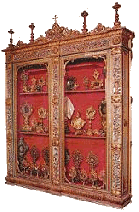S. Philip’s Chapel
|
|
| S. Philip’s Chapel |
The altar, of Derbyshire alabaster, was designed by Sir George Gilbert Scott (1811-1878) and the rest of the sanctuary is by his son. The altarpiece is another copy of Guido Reni’s S. Philip. The chapel was redecorated and restored in 1984-1985 to commemorate the 70th anniversary of ordination to the priesthood of F. Philip Lynch. As a result of this work the altar gained the three panels which reproduce the design on the tabernacle doors. Happily these panels were executed by Mr Patrick Feeny who had designed and supervised the decorations of 1959.
The columns at the rear of the chapel are copied from those in the Cappella Palatina in Pelermo, which Newman had sketched while on his Mediterranean voyage in 1833. Above, are placed portraits of several saints: on the front SS. Charles Borromeo, Ignatius Loyola, John Leonardi and Felix of Cantalice, all friends of S. Philip; on the rear SS. Cecilia and Sebastian.
 |
| Relic Case |
The chapel houses the fine wooden gilt case, made by Sr Ernesto Sensi, which contains a large number of beautiful reliquaries and interesting relics, in particular some of the English Martyrs SS. Thomas More, John Southworth, Philip Howard , Oliver Plunkett, Cuthbert Mayne and Edmund Campion. There is a fine bust of S. Philip, a relic of the True Cross and relics of most of the great post-Reformation saints, in addition to some relics of SS. Gregory the Great, Anthony of Padua, Thérèse of Lisieux and an autograph of her namesake, S. Teresa of Avila.
top^
